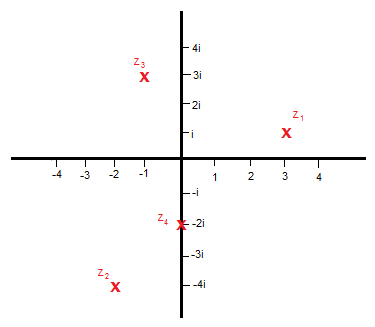Modulus and Argument
The Argand Diagram
Definition
An Argand diagram has a horizontal axis, referred to as the real axis, and a vertical axis, referred to as the imaginary axis.
A complex number $z = a + bi$ is plotted at coordinates $(a,b)$, as $a$ is the real part of the complex number, and $b$ the imaginary part.

|center
Worked Example
Example 1
Plot the following complex numbers on an Argand diagram.
\begin{align} z_1 &= 3+i \\ z_2 &= -2-4i \\ z_3 &=-1+3i \\ z_4 &= -2i \end{align}
Solution

Modulus and Argument
Definition
Any complex number $z$ can be represented by a point on an Argand diagram. We can join this point to the origin with a line segment. The length of the line segment is called the modulus of the complex number and is denoted $\lvert z \rvert$. The angle measured from the positive real axis to the line segment is called the argument of the complex number, denoted $arg(z)$ and often labelled $\theta$. The modulus and argument can be calculated using trigonometry.

|center
The modulus of a complex number $z = a + b i$ is \[\lvert z \rvert = \sqrt{a^2+b^2}\]
When calculating the argument of a complex number, there is a choice to be made between taking values in the range $[-\pi,\pi]$ or the range $[0,\pi]$. Both are equivalent and equally valid. On this page we will use the convention $-\pi \lt \theta \lt \pi$.
The 'naive' way of calculating the angle to a point $(a,b)$ is to use $\arctan(\frac{b}{a})$ but, since $\arctan$ only takes values in the range $[-\frac{\pi}{2},\frac{\pi}{2}]$, this will give the wrong result for coordinates with negative $x$-component. You can fix this by adding or subtracting $\pi$, depending on which quadrant of the Argand diagram the point lies in.

- First quadrant: $\theta = \arctan \left(\dfrac{b}{a}\right)$.
- Second quadrant: $\theta = \arctan \left(\dfrac{b}{a}\right) + \pi$.
- Third quadrant: $\theta = \arctan \left(\dfrac{b}{a}\right) -\pi$.
- Fourth quadrant: $\theta = \arctan \left(\dfrac{b}{a}\right)$.
It's a good idea to draw an Argand diagram of the complex number when making the decision about which formula to use.
Note: be careful to watch out for the case when $a=0$, i.e. the complex number has no real part. In this case, the $\arctan$ method doesn't work, but the argument is either $\frac{\pi}{2}$ or $-\frac{\pi}{2}$ for numbers with positive and negative imaginary parts, respectively.
Example
$z_1=1+i$ has the argument \[\arg z_1 = \arctan \left(\dfrac{1}{1}\right) = \arctan (1) = \dfrac{\pi}{4}.\]
However, the same calculation for $z_2=-1-i$ gives $\arctan \left(\frac{-1}{-1}\right) = \arctan (1) = \dfrac{\pi}{4}$, the same number!
If we draw $z_2$ on an Argand diagram, we can see that it falls in the third quadrant, so the argument should be between $-\frac{\pi}{2}$ and $-\pi$. We must subtract $\pi$ to correct this and therefore get $\arg z_2 = -\dfrac{3\pi}{4}$.
Worked Examples
Example 1
Find the modulus and argument of the complex number $z = 3+2i$.
Solution

|center
\begin{align} \lvert z \rvert &= \sqrt{3^2+2^2}\\ &=\sqrt{9+4}\\ &=\sqrt{13} \end{align}
As the complex number lies in the first quadrant of the Argand diagram, we can use $\arctan \frac{2}{3}$ without modification to find the argument.
\begin{align} \arg z &= \arctan \left(\frac{2}{3}\right) \\ &=0.59 \text{ radians (to 2 d.p.)} \end{align}
Example 2
Find the modulus and argument of the complex number $z=4i$.
Solution

|center
\begin{align} \lvert z \rvert &= \sqrt{0^2+4^2}\\ &=\sqrt{16}\\ &=4 \end{align}
The simplest way to find the argument is to look at an Argand diagram and plot the point $(0,4)$. The point lies on the positive vertical axis, so \[\arg z = \frac{\pi}{2}\]
Example 3
Find the modulus and argument of the complex number $z = -2+5i$.
Solution

|center
\begin{align} \lvert z \rvert &= \sqrt{(-2)^2+5^2}\\ &=\sqrt{4+25}\\ &=\sqrt{29} \end{align}
As $z$ is in the second quadrant of the Argand diagram, we need to add $\pi$ to the result obtained from $\arctan \left(\frac{5}{-2}\right)$.
\begin{align} \arg z &= \arctan \left(\frac{5}{-2}\right) + \pi \\ &=-1.19 + \pi \\ &= 1.95 \text{ radians (to 2 d.p.)} \end{align}
Example 4
Find the modulus and argument of the complex number $z = -4-3i$.
Solution

|center
\begin{align} \lvert z \rvert &= \sqrt{(-4)^2+(-3)^2}\\ &=\sqrt{16+9}\\ &=\sqrt{25}\\ &=5 \end{align}
As $z$ lies in the third quadrant of the Argand diagram, we need to subtract $\pi$ from the result of $\arctan \left(\frac{-3}{-4}\right)$.
\begin{align} \arg z &= \arctan \left(\frac{-3}{-4}\right) - \pi\\ &= \arctan \left(\frac{3}{4}\right) - \pi\\ &= 0.64 - \pi \\ &= -2.50 \text{ radians (to 2 d.p.)} \end{align}
Note: Alternatively, the answer could have been given in the range $0 \lt \theta \lt 2\pi$, where we would have added $\pi$, instead of subtracting it, and got an answer of $\arg z = 3.67$ radians (to 2 d.p.)
Example 5
Find the modulus and argument of the complex number $z = 1-4i$.
Solution

|center
\begin{align} \lvert z \rvert &= \sqrt{1^2+(-4)^2}\\ &=\sqrt{1+16}\\ &=\sqrt{17} \end{align}
As $z$ lies in the fourth quadrant of the Argand diagram, we don't need to modify the result of $\arctan \left(\frac{-4}{1}\right)$ to find the argument.
\begin{align} \arg z &= \arctan \left(\frac{-4}{1}\right)\\ &= \arctan \left(-4\right) \\ &= -1.33 \text{ radians (to 2 d.p.)} \end{align}
Video Example
Prof. Robin Johnson draws the complex numbers $z=-1-i$ and $z=-4+3i$ on an Argand diagram, and finds their modulus and argument.
Workbook
This workbook produced by HELM is a good revision aid, containing key points for revision and many worked examples.
Test Yourself
Test yourself: Numbas test on finding the modulus and argument
External Resources
- The Argand diagram leaflet at mathcentre.
- The modulus and argument of a complex number leaflet at mathcentre.